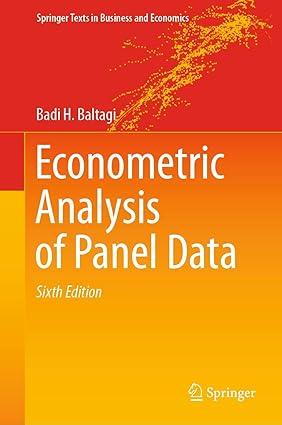This is based on problem 97.2.1 in Econometric Theory by Baltagi and Krmer (1997). Consider the following
Question:
This is based on problem 97.2.1 in Econometric Theory by Baltagi and Krämer (1997). Consider the following simple linear trend: model
\[y_{i t}=\alpha+\beta t+u_{i t} \quad i=1,2, \ldots, N, \text { and } t=1,2, \ldots, T\]
where \(y_{i t}\) denotes the gross domestic product of country \(i\) at time \(t\). The disturbances follow the one-way error component model given by
\[u_{i t}=\mu_{i}+u_{i t}\]
where \(\mu_{i} \sim \operatorname{IID}\left(0, \sigma_{\mu}^{2}\right)\) denote the random country (time-invariant) effects and \(u_{i t} \sim \operatorname{IID}\left(0, \sigma_{u}^{2}\right)\) denote the remainder effects. These error components are assumed to be independent of each other and among themselves. Our interest focuses on the estimates of the trend coefficient \(\beta\), and the estimators to be considered are ordinary least squares (OLS), first difference (FD), the fixed effects (FE) estimator, assuming the \(\mu_{i}\) 's are fixed effects, and the generalized least squares estimator (GLS), knowing the true variance components, which is the best linear unbiased estimator in this case.
(a) Show that the OLS, GLS, and FE estimators of \(\beta\) are identical and given by \(\widehat{\beta}_{G L S}=\widehat{\beta}_{O L S}=\widetilde{\beta}_{F E}=\sum_{i=1}^{N} \sum_{t=1}^{T} y_{i t}(t-\bar{t}) / N \sum_{t=1}^{T}(t-\bar{t})^{2}\) where \(\bar{t}=\) \(\sum_{t=1}^{T} t / T\).
(b) Show that the variance of the OLS, GLS, and FE estimators of \(\beta\) is given by \(\operatorname{var}\left(\widehat{\beta}_{G L S}\right)=\operatorname{var}\left(\widehat{\beta}_{O L S}\right)=\operatorname{var}\left(\widetilde{\beta}_{F E}\right)=12 \sigma_{u}^{2} / N T\left(T^{2}-1\right)\) and is therefore \(O\left(N^{-1} T^{-3}\right)\).
(c) Show that this simple linear trend model satisfies the necessary and sufficient condition for OLS to be equivalent to GLS.
(d) Show that the FD estimator of \(\beta\) is given by \(\widehat{\beta}_{F D}=\sum_{i=1}^{N}\left(y_{i T}-y_{i 1}\right) / N(T-\) 1) with \(\operatorname{var}\left(\widehat{\beta}_{F D}\right)=2 \sigma_{u}^{2} / N(T-1)^{2}\) of \(O\left(N^{-1} T^{-2}\right)\).
(e) What do you conclude about the asymptotic relative efficiency of FD with respect to the other estimators of \(\beta\) as \(T \rightarrow \infty\) ?
Step by Step Answer:






